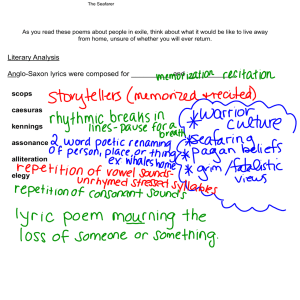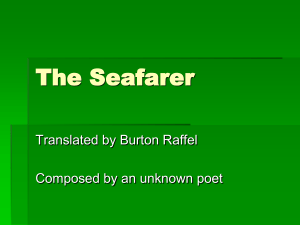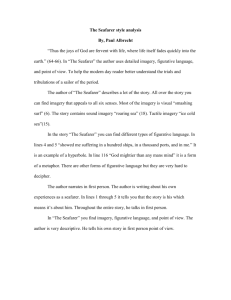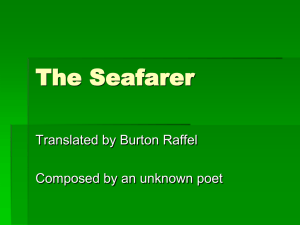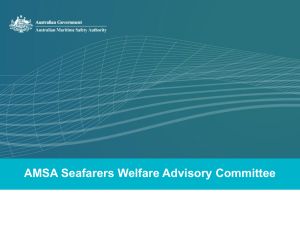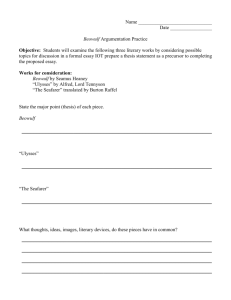MSN 1842 (M)
advertisement
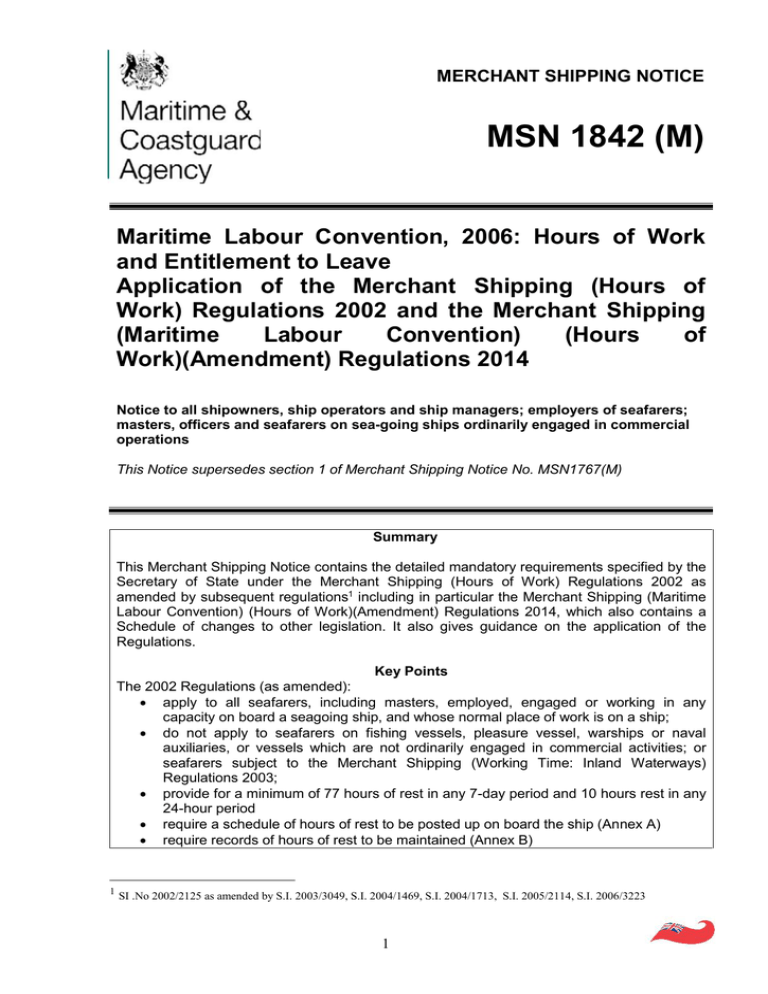
Maritime and Coastguard Agency LogMERCHANT SHIPPING NOTICE MSN 1842 (M) Maritime Labour Convention, 2006: Hours of Work and Entitlement to Leave Application of the Merchant Shipping (Hours of Work) Regulations 2002 and the Merchant Shipping (Maritime Labour Convention) (Hours of Work)(Amendment) Regulations 2014 Notice to all shipowners, ship operators and ship managers; employers of seafarers; masters, officers and seafarers on sea-going ships ordinarily engaged in commercial operations This Notice supersedes section 1 of Merchant Shipping Notice No. MSN1767(M) Summary This Merchant Shipping Notice contains the detailed mandatory requirements specified by the Secretary of State under the Merchant Shipping (Hours of Work) Regulations 2002 as amended by subsequent regulations1 including in particular the Merchant Shipping (Maritime Labour Convention) (Hours of Work)(Amendment) Regulations 2014, which also contains a Schedule of changes to other legislation. It also gives guidance on the application of the Regulations. Key Points The 2002 Regulations (as amended): apply to all seafarers, including masters, employed, engaged or working in any capacity on board a seagoing ship, and whose normal place of work is on a ship; do not apply to seafarers on fishing vessels, pleasure vessel, warships or naval auxiliaries, or vessels which are not ordinarily engaged in commercial activities; or seafarers subject to the Merchant Shipping (Working Time: Inland Waterways) Regulations 2003; provide for a minimum of 77 hours of rest in any 7-day period and 10 hours rest in any 24-hour period require a schedule of hours of rest to be posted up on board the ship (Annex A) require records of hours of rest to be maintained (Annex B) 1 SI .No 2002/2125 as amended by S.I. 2003/3049, S.I. 2004/1469, S.I. 2004/1713, S.I. 2005/2114, S.I. 2006/3223 1 provide for employed seafarers (as defined) 2.5 days of paid annual leave per month of employment, and an additional 8 days of paid leave per year in respect of public holidays (both pro-rated for shorter periods) give employed seafarers (as defined) the right to take a case regarding their entitlements to paid leave to an employment tribunal require shipowners to grant shore leave to benefit seafarers’ health and well-being, where compatible with their operational duties (not applicable to ships of traditional build) provide for inspection and enforcement by the MCA An unofficial consolidated version of the regulations is available on request from mlc@mcga.gov.uk Relationship with the Merchant Shipping (Hours of Work) Regulations 2002, as amended The Merchant Shipping (Hours of Work) Regulations 2002, as amended, need to be read together with this Merchant Shipping Notice (MSN), as this MSN sets out some of the details, standards and formalities which must be observed in order to comply with the legal obligations under the Regulations. Failure to comply with those obligations may be a criminal offence under the Regulations. In order to assist with this Paragraph 16 contains an index which identifies the provisions in this Notice which relate to the relevant provision in the Regulations. 1. Introduction 1.1 The Merchant Shipping (Hours of Work) Regulations 2002, as amended, (referred to in this Notice as “the Regulations”), implement for the UK: a. Regulations 2.3 and 2.4 of the Maritime Labour Convention on hours of work and rest and entitlement to leave b. Clauses 1- 5, 7 – 10, 12 and 16 of the Annex (the Social Partners' agreement) to Council Directive 1999/63/EC of 21 June 1999 (the Maritime Working Time Directive), as amended by Council Directive 2009/13/EC c. Regulations 2.3 and 2.4 of the Annex (the Social Partners’ Agreement) to Council Directive 2009/13/EC d. Council Directive 1999/95/EC concerning inspection and enforcement e. Regulation VIII/1 of the International Convention on Standards of Training, Certification and Watchkeeping for Seafarers (STCW, including 2010 Manila amendments). 1.2 The Regulations also provide for penalties in the event of non-compliance. 2. Application 2.1 The Regulations (as amended) apply to seafarers on board a UK seagoing ship wherever it may be, and on non-UK ships in UK waters. They do not apply to seafarers working on a fishing vessel, pleasure vessel, warship or naval auxiliary, or any vessel not ordinarily engaged in commercial activities, nor to any seafarer who is subject to the Merchant Shipping (Working Time: Inland Waterways) Regulations 2003. The entitlements to paid leave apply to employed seafarers and this term is defined in a way that includes seafarers who are contractors engaged under a contract for services (see paragraph 9.5). -2- 2.2 The Regulations therefore apply to government ships which are ordinarily engaged in commercial maritime operations. Government ships such as those operated by the Royal Fleet Auxiliary, which are not ordinarily engaged in commercial maritime operations are not covered by the Regulations. 2.3 All vessels engaged in trade, carrying cargo or fare-paying passengers, are covered as are charter yachts and sail training vessels, including vessels certificated under MCA Codes of Practice for small commercial vessels, and harbour tugs (other than those operating exclusively in Category A to D waters under MSN 1837(M)). 2.4 Seafarer 2.4.1 A Seafarer is defined in the Regulations as any person, including the master, employed or engaged or working in any capacity on board a seagoing ship, whose normal place of work is on a ship. Boatmaster's licence holders operating on seagoing vessels, and those working in the harbour towage industry are subject to these Regulations. 2.4.2 A person whose normal place of work is ashore but who is working on a ship on a temporary or one-off basis for the duration of a voyage is excluded. These workers are covered by the requirements of the Working Time Regulations 19982. For guidance on how the MCA applies the meaning of seafarer in its enforcement activities, see MGN 471(M). 2.4.3 There are separate working time regimes for workers on fishing vessels (MSN 1769(F) and mobile workers on inland waterways (MSN 1786(M)). 2.5 Employed Seafarer For the definition of employed seafarer see paragraph 9.5. 3. General Duties (Regulation 4) 3.1 The Regulations require that the shipowner3, the employer (in the case of an employed seafarer) and the master must ensure that seafarers are provided with at least the minimum hours of rest. 3.2 It is the responsibility of all seafarers to ensure that they are properly rested when they begin duty on a ship and that they obtain adequate rest when not on duty. 3.3 Additional guidance Day to day monitoring of compliance with minimum hours of rest is likely to be part of the duties of the Master. However, on ships with many different departments, the master may delegate the monitoring of hours of rest to department managers, including the managers of franchises, who are responsible for the personnel working for the franchise, and any employer of a seafarer working on board the vessel. However, the legal responsibility remains with the shipowner, employers and the master to ensure that the Regulations are complied with. 4. Minimum Hours of Rest (Regulation 5) 4.1 Definition of Hours of Work 2 S.I. No 1998/1833 3 See regulation 2(1) for the definition of shipowner. Additional guidance as to the MCA’s application of the definition is in MGN 471(M). -3- 4.1.1 For the purposes of the Regulations, hours of work are when seafarers are required to do work on the business of the ship. On-Call Time – On-call time is not counted as “hours of work” unless the seafarer is required to work during that time. The Regulations provide that a seafarer whose normal period of rest on board ship is disturbed by a call-out, should have compensatory rest. An example is where a seafarer, having set the alarms in an unattended machinery space, retires to his bunk but has his rest disturbed by a call-out to work. In such circumstances, the seafarer is entitled to compensatory rest to make up for the rest time lost because he was called out to work. 4.2 Definition of Hours of Rest 4.2.1 For the purposes of the Regulations, hours of rest means time outside hours of work, and does not include short breaks. 4.3 The minimum hours of rest shall be not less than: (a) ten hours in any 24-hour period; and (b) 77 hours in any seven-day period. 4.4 The daily hours of rest may be divided into no more than two periods, one of which must be at least 6 hours long and the interval between periods of rest must be no more than 14 hours. Those two periods must in total provide at least 10 hours rest. 4.5 The regulations provide that a seafarer must have 10 hours of rest in any 24-hour period. 4.6 Additional guidance: Any periods of rest of one hour or more additional to the one or two periods making up the minimum of 10 hours of rest in a 24-hour period may be counted towards the weekly rest total. A 24-hour period is normally counted from the start of the main period of work, but may be counted from the start of any period of work. 5. Exceptions to the limits on Hours of Rest (Regulation 6) 5.1 Exceptions to the limits on the hours of rest may be authorised by the MCA provided that they are the result of an agreement between employers and seafarers, have due regard to the general principles of health and safety of workers, and comply with the limits set out in MGN 448(M)4. 5.2 Agreements can be either a “collective agreement” (between the employer and an independent trade union) or a “workforce agreement” (between the employer and the employees or their elected representatives and meeting the conditions in Schedule 1 to the Regulations). Exceptions may take account of more frequent or longer leave periods or the granting of compensatory leave for watchkeeping seafarers or seafarers working on board ships on short voyages. 5.3 A workforce agreement is made with elected representatives of the workforce in most cases (see below). It can apply to the whole workforce or to a group of workers. A workforce agreement must: - be in writing 4 MGN 448(M) explains the limits on exceptions to hours of rest laid down by the STCW Convention, as amended in 2010 (“the Manila amendments”) Code A/VIII.1/9 -4- - have been circulated in draft to all workers to whom it applies together with guidance to assist their understanding of it; - be signed before it comes into effect: by the elected representatives of the members of the workforce or group of workers; or if there are 20 or fewer employed by a company, either by the elected representatives of a workforce or by a majority of the workforce; - have effect for a specified period of no more than five years. 5.4 Applications for authorization of exceptions should be made in writing to any MCA Marine Office (listed on our website at http://www.dft.gov.uk/mca/mcga07-home/aboutus/contact07/marineoffices.htm ). 6. Posting-up of Table of Duties (Regulation 7) 6.1 Shipowners must ensure that a table or schedule of duties is produced, setting out the hours of work and rest periods. The table must be in English and in the working language of the ship, if that is not English. 6.2 The table must be in the same format as Annex A(i) and (ii) to this Notice, or in a format substantially like it. The table must contain at least the following information for every seafarer: (a) the daily schedule of duties at sea and duties in port; and (b) the daily minimum hours of rest as required by the Regulations (see para 4.1 above) or any collective or workforce agreements in force. 6.3 The master or a person authorised by the master must ensure that the table is posted in a prominent and easily accessible place in the ship. Where there is more than one table, the master or authorised person is responsible for ensuring that all tables are posted in a suitable place. Additional guidance 6.4 In devising the schedule, shipowners should take account of factors such as: a) b) c) d) e) f) g) h) trade and type of operation,; type and size of ship; construction and technical equipment of the ship; manning levels and changes in crew numbers due to crew changes and sickness; the maximum period of continuous watchkeeping; minimum rest periods; total workload; the seriousness of irregular working hours and their contribution to causing fatigue and the importance of scheduling reasonably stable working hours over a voyage. 6.5 Changes should not be made to the schedule of duties unless they can be justified by substantially altered work patterns made necessary, for example, by a change in trading pattern or other significant factor. Where it is known that a ship engages in an irregular working pattern or that working hours are unlikely to be uniform, this can be taken into account and recorded in the schedule. -5- 6.6 It is not necessary to draw up a new schedule of duties for each voyage, so long as the schedule used is applicable to the voyage in question and the composition of the crew for whom it was originally intended has not changed. 6.7 When first drawing up the schedule of duties for a ship, shipowners should seek the views of the master, who should in turn seek the views of the officers, the ship’s safety committee (if applicable) or the seafarers or their representatives or a trade union as appropriate. The final decision on the schedule lies with the shipowner who will be responsible for ensuring that it is appropriate in relation to the safety of the ship and the performance of duties. 7. Exceptions for Emergencies (Regulation 8) 7.1 The Regulations recognise that situations may arise in which a seafarer may be required by the master to work during scheduled hours of rest. These include emergencies which threaten the safety of the ship, persons on board or the cargo or where another ship or person in distress requires assistance. In these circumstances, hours of rest schedules may be suspended until the normal situation is restored. The master shall ensure that any affected seafarer is then given an adequate rest period to avoid fatigue. 8. Records (Regulation 9) 8.1 The master or authorised person must ensure that records of hours of rest are maintained for all seafarers serving on the ship. (Reg 9(1)) 8.2 The records must be completed at least monthly in arrears and must be in the format at Annex B to this Notice or an equivalent format containing the same information. The records, once endorsed in accordance with regulation 9(4) (see paragraph 8.4), must be retained for at least one year. Records must be available for inspection by MCA surveyors at any time. (Reg 9(2)) 8.3 The records must be in English, and in the working language of the ship if that is not English. (Reg 9(3)) 8.4 Each record must be endorsed by the master or authorised person and the seafarer. A copy must be given to the seafarer. (Reg 9(4)) Additional guidance 8.5 When an unforeseen emergency occurs (as described in paragraph 7) changes may be unavoidable. In these cases, records should reflect all deviations from the schedule. 8.6 If during the period when the records are being retained, a company ceases to operate, the duty to retain the records remains with that company. 8.7 Checking the ship’s documentation will be carried out by the MCA as part of the MLC survey or inspection, and may be carried out at any other time as part of the routine of ship inspection. This will include a check that the appropriate schedules are posted and records maintained. Following examination, the records will be endorsed as part of the process. 9. Entitlement to Annual and Additional Leave (Regulation 12) 9.1 This section deals with the annual and additional leave entitlements under the Regulations, which are together referred to in this guidance for convenience as “paid statutory leave”. -6- 9.2 Under the Regulations as amended, an employed seafarer (as defined) is entitled to paid annual leave of two and a half days for each month of employment in the leave year (which over a full year totals 30 days). Seafarers cannot be paid in lieu of their annual leave entitlement under the Regulations, unless their contract is terminated. The 2.5 days’ paid leave for each month of employment is referred to as “paid annual leave” in this guidance. 9.3 In addition an employed seafarer is entitled to 8 days’ paid leave each leave year in respect of public holidays. 9.4 In either case, where an employed seafarer works for a shorter period than a month or a leave year, the paid leave entitlement must be calculated pro-rata. This is likely to apply not only to seafarers employed for short periods, but also to seafarers whose period of employment includes part of a leave year or month. Part time employed seafarers will also receive pro-rated leave entitlements under general principles. 9.5 Employed seafarer: An employed seafarer Is defined in regulation 2(4) as a seafarer who is employed under a contract of employment or engaged (or, where the employment or engagement has ceased, was employed or engaged), “employer” in relation to an employed seafarer means the person by whom the employed seafarer is or was employed or engaged and “employment” in relation to an employed seafarer is to be construed accordingly. and “engaged” is defined in regulation 2(4) as “engaged”, in the application of these Regulations to seafarers, means engaged under a contract, whether express or implied and (if it is express) whether oral or in writing, whereby the seafarer undertakes to do or perform personally any work or services for another party to the contract whose status is not by virtue of the contract that of a client or customer of any profession or business undertaking carried out by the seafarer. The definition of employed seafarer is based on the definition of “worker” in the Working Time Regulations 1998. A person who is considered “self-employed” for tax purposes by HMRC may nevertheless be an “employed seafarer” under this definition. A seafarer is not an “employed seafarer” if they are working as part of their own business in an arrangement where the shipowner is actually a customer or client – for example, a contractor providing technical support to ships, who spends extended periods at sea. 9.6 Justified absences from work must not be counted as paid annual leave. 9.7 Justified absences include an absence authorised by any enactment, contract between the seafarer’s employer and the seafarer, collective agreement or workplace agreement or by custom and practice. Examples are given at paragraph 9.10. 9.8 It is the employer’s responsibility to comply with regulation 12. The new entitlement takes effect from the day that the 2014 amending Regulations come into force, and employers should apply this pro-rata for employed seafarers part-way through a leave year on that date so as to give the seafarer the benefit of the increased paid statutory leave for the part of the leave year which starts on the date that the 2014 amending Regulations come into force. The practical arrangements for the taking of leave where the seafarer's entitlement is increased part-way through a leave year as a result of the amending Regulations are a matter for agreement between the employer and the seafarer -7- Guidance on paid statutory leave entitlement 9.9 The level of pay during paid statutory leave should be at the seafarer’s normal level of remuneration. 9.10 Detailed arrangements for leave are to be agreed between the employer and seafarer, and the following are examples of justified absences which should not be counted as part of paid annual leave: absence from work to attend an approved maritime vocational training course, or any course which the employer requires to be undertaken; “approved maritime vocational training course” means any training course approved by the MCA (or another competent authority) for seafarer training required for the role currently undertaken or, in the case of a cadet, for the completion of a cadetship or for the seafarer’s next certificate of competency; periods of absence as a result of sickness or injury (unless, in the case of a seafarer on sick leave, the seafarer chooses to take paid annual leave); leave arising as a result of any statutory entitlement applicable to the individual seafarer, such as maternity or paternity leave temporary shore leave, other than in cases where the seafarer requests annual leave while the ship is in port; compensatory leave, including compensatory leave under regulation 6(2); 9.11 Paid periods off work which form part of an employed seafarer’s agreed pattern of work (eg one month on, one month off) may include paid leave, as well as leave in recognition of long hours worked while the seafarer is on board ship. The nature of this leave should be made clear in the seafarer’s employment agreement. 9.12 Entitlement to paid statutory leave continues to accrue during periods of employment off articles (e.g. during a scheduled period ashore as part of the agreed pattern of work). 9.13 The time at which leave is to be taken is a matter to be determined between the employed seafarer and the employer. 9.14 Employed seafarers should in principle be able to take paid annual leave in the place with which they have a substantial connection, which would normally be the same as the place to which they are entitled to be repatriated. This should be specified in the seafarer’s employment agreement. Except with their consent or provided for in the seafarer’s employment agreement, seafarers should not be required to take paid annual leave due to them in another place. If seafarers are required by the shipowner to take their paid annual leave from a place other than the place with which they have a substantial connection, they should be entitled to the costs of transport to the place where they were engaged or recruited, whichever is nearer their home, and subsistence for the journey. The travel time involved should not be deducted from the paid annual leave due to the seafarer. The divisions of paid leave into parts, and the carry-over of any paid leave from one year to another, are matters to be agreed between the employed seafarer and employer. -8- 9.15 Particular regard should be had to the need to facilitate leave for young seafarers under the age of 18 years who have served for 6 months (or other shorter agreed period) on foreign-going ships that have not returned to their country of residence in that time and will not return in the subsequent 3 months of the voyage. It may, for example, be appropriate to provide for a paid home visit to take any leave earned during the voyage. 9.16 Emergency recall from leave A seafarer taking paid annual leave should be recalled only in cases of extreme emergency and with the seafarer’s consent. 9.17 When the employed seafarer’s leave year begins and ends is determined by agreement between employee and employer. However if there is no such agreement and the seafarer’s employment began before 30 June 2002 then the leave year should be treated as beginning on that date and each 30 June thereafter. If there is no agreement and the seafarer’s employment begins after 30 June 2002 then the leave year begins on the date on which employment begins and each subsequent anniversary of that date. 10. Shore leave (Regulation 12A) 10.1 The shipowner and the master must ensure that shore leave is granted to seafarers to benefit their health and well-being where consistent with the operational requirements of their positions. 10.2 There is no absolute duty to give seafarers shore leave in all circumstances, but it must be given where such leave is compatible with the seafarer’s operational duties, and benefits the seafarer’s health and wellbeing. An example of where shore leave may not benefit the seafarer’s health and well-being is where there is public disorder or a security risk in the port. 10.3 The duty is placed on the shipowner (which has responsibility for the operation of the ship) and the master (who has day to day control of operations). 10.4 The statutory duty to give shore leave does not apply to ships of traditional build, because the MLC (and therefore Directive 2009/13/EC) does not apply to such ships. However, allowing seafarers shore leave where practicable is of course recognised good practice on any ship. 11. Specific enforcement provisions for hours of work (Regulations 15 and 16) 11.1 Regulations 15 and 16 implement Council Directive 1999/95 EC concerning enforcement provisions in relation to hours of work requirements and apply to all nonUK ships, whether or not the ship has a Maritime Labour Certificate. They sit alongside the standard MLC enforcement provisions contained in regulations 14, 14A, 17A and 17B, which take account of whether or not the ship has a Maritime Labour Certificate. 11.2 Compliance with the regulations will be checked as part of the MLC survey or inspection on ships to which that applies. In addition, inspection of hours of work will continue to form part of MCA’s general inspection regime. Inspection of a non-UK ship undertaken using regulation 15 powers may be triggered by a complaint from a person or body with a legitimate interest in the safety of the ship including health and safety of the crew. In such cases the identity of the complainant will remain confidential. 11.3 Inspection of non-UK ships under regulation 15 will include a check that an appropriate table of working schedules is posted up as required by regulation 7 and -9- that records of work and rest periods are being maintained in accordance with regulation 9. If an inspector has grounds for believing that seafarers may be unduly fatigued or a complaint has been received which is not manifestly unfounded, the inspector will check in more detail that the hours of rest recorded conform to the standards and that they have actually been observed. If the evidence indicates that manning levels are so low that the schedules cannot be observed, the MCA will take action to rectify the deficiency which is likely to include requiring that manning levels are adjusted so that the vessel can operate safely within the hours available. Where conditions are clearly hazardous to safety or health, the ship may be detained. 12. Release of information (Regulation 19) MCA is required to ensure the publication of information about all ships inspected under regulation 15 or detained under regulation 16 of these Regulations. This is done through reporting procedures to the Paris Memorandum of Understanding and publication by the European Commission of information that has been reported on the THETIS database. The information to be reported and published is specified at Annex C. 13. Remedies (Regulations 20 and 22) 13.1 Non-compliance with the requirements of the Regulations is a criminal offence. Also an employed seafarer may bring a claim before an employment tribunal (or industrial tribunal in Northern Ireland) to enforce his entitlement to paid leave or to payment in lieu of paid leave when the seafarer’s employment ends. 13.2 As with shore-based workers, a claim should normally only be made where inhouse dispute resolution procedures have been followed and failed to reach a resolution. The Maritime Labour Convention introduces complaints procedures both on board ship and ashore (see MSN 1849(M) and MGN 487(M)), and these procedures are in line with the ACAS procedures. In considering a case, the Employment Tribunal is likely to consider whether efforts have been made to resolve the case between the employer and the employed seafarer at a company level. Evidence that the MLC procedures have been followed will demonstrate that this is the case. 13.3 There is a 3-month time limit for bringing a case to an Employment Tribunal, but the Tribunal has discretion to extend this limit where it is not reasonably practicable to present the claim within the time limit. Claims may be submitted by post or e-mail and being out of the country is not on its own likely to be a sufficient reason for not meeting the deadline. 13.4 For further information on taking a claim to an Employment Tribunal see https://www.gov.uk/employment-tribunals/taking-a-case-to-an-employment-tribunal 14. Protection for seafarers’ rights under these Regulations (Regulation 23 and Schedule to the 2014 Regulations) 14.1 Regulation 23 and the Schedule to the 2014 Regulations ensure that seafarers exercising their rights under these Regulations, and seafarers bringing a complaint to an employment tribunal in respect of their entitlement to paid leave, are protected in the same way as those working in other sectors, for example against dismissal or detrimental treatment. - 10 - 15. Restriction on contracting out 15.1 In particular, regulation 23 invalidates any agreement which purports to exclude or limit any provision of the Regulations. (There are exceptions for agreements to settle a claim or possible claim which meet specified conditions). 16. References to this Notice in the Merchant Shipping (Hours of Work) Regulations, as amended 16.1 The references to this Notice in the Merchant Shipping (Hours of Work) Regulations 2002 as amended by the Merchant Shipping (Maritime Labour Convention) (Hours of Work) (Amendment) Regulations 2014 are indexed below. This is the version of Merchant Shipping Notice 1842(M) which is considered to be relevant until further notice. Regulation 7(2)(a) and (b) : The information to be contained in a table of scheduled hours of rest, and the standard format of such a table, are set out in paragraph 6.2 and in Annex A. Regulations 9(2) : The procedures for keeping records of hours of rest, and the format for such records, are set out in paragraph 8.2 and in Annex B. Regulation 19 : The information to be published by the MCA each month concerning ships which have been inspected under regulation 15 (inspection of ships other than UK ships) or detained under regulation 16 (rectification of deficiencies in such ships), is specified at paragraph 12 and Annex C. Any further queries relating to this Notice should be addressed to the MCA at the address below: - 11 - More Information Seafarer Safety and Health Branch Maritime and Coastguard Agency, Bay 1/29 Spring Place, 105 Commercial Road, Southampton, SO15 1EG. Tel : Fax : e-mail: +44 (0) 23 8032 9216. +44 (0) 23 8032 9251. mlc@mcga.gov.uk. General Inquiries: infoline@mcga.gov.uk . MCA Website Address: www.dft.gov.uk/mca . File Ref: MS 122/6/78 Published: February 2014 Please note that all addresses and telephone numbers are correct at time of publishing. © Crown Copyright 2013. Safer Lives, Safer Ships, Cleaner Seas. - 12 - Annex A(i) MODEL FORMAT FOR TABLE OF SHIPBOARD WORKING ARRANGEMENTS (1) Name of Ship: _________________________________ Flag of Ship: ________________________ IMO number (if any): _________________________ Latest update of table: _____________________________________________________ ( ) of ( ) pages. The minimum hours of rest are applicable in accordance with the Merchant Shipping (Hours of Work) Regulations 2002 (as amended) issued in conformity with ILO’s Maritime Labour Convention, 2006 and with any applicable collective agreement registered or authorised in accordance with that Convention and with the International Convention on Standards of Training, Certification and Watchkeeping for Seafarers 1978, as amended (including 2010 Manila Amendments) (2). Minimum hours of rest: ___________________________________________________________________ Other requirements: ____________________________________________________________________________________________________ Position/rank (3) Scheduled daily work hours at sea Watchkeeping (from – to) Non-watchkeeping duties (from – to) Scheduled daily work hours in port Watchkeeping (from – to) Comments Non-watchkeeping duties (from – to) Total daily rest hours At sea In ports Signature of Master: _______________________________________ (1) The terms used in this model are to appear in the working language or languages of the ship and in English. (2) See overleaf for selected extracts from the ILO Maritime Labour Convention, 2006 and the STCW Convention. (3) For those positions/ranks that are also listed in the ship’s safe manning document, the terminology used should be the same as in that document. (4) For watchkeeping personnel, the comment section may be used to indicate the anticipated number of hours to be devoted to unscheduled work and any such hours should be included in the appropriate total daily work hours. - 13 - Annex A(ii) SELECTED TEXTS FROM THE MARITIME LABOUR CONVENTION, 2006 AND THE STCW CONVENTION Maritime Labour Convention, 2006 Standard A2.3 5. The limits on hours of work or rest shall be as follows: (a) maximum hours of work shall not exceed: (i) 14 hours in any 24-hour period; and (ii) 72 hours in any seven-day period; or (b) minimum hours of rest shall not be less than: (i) ten hours in any 24-hour period; and (ii) 77 hours in any seven-day period. 6. Hours of rest may be divided into no more than two periods, one of which shall be at least six hours in length, and the interval between consecutive periods of rest shall not exceed 14 hours. 13. Nothing in paragraphs 5 and 6 of this Standard shall prevent a Member from having national laws or regulations or a procedure for the competent authority to authorize or register collective agreements permitting exceptions to the limits set out. 14. Nothing in this Standard shall be deemed to impair the right of the master of a ship to require a seafarer to perform any hours of work necessary for the immediate safety of the ship, persons on board or cargo, or for the purpose of giving assistance to other ships or persons in distress at sea. Accordingly, the master may suspend the schedule of hours of work or hours of rest and require a seafarer to perform any hours of work necessary until the normal situation has been restored. As soon as practicable after the normal situation has been restored, the master shall ensure that any seafarers who have performed work in a scheduled rest period are provided with an adequate period of rest. STCW Convention Section A-VIII/1 of the STCW Code (Mandatory) 2. All persons who are assigned duty as officer in charge of a watch or as a rating forming part of a watch and those whose duties involve designated safety, prevention of pollution and security duties shall be provided with a rest period of not less than: .1 a minimum of 10 hours rest in any 24-hour period; and .2 77 hours in any 7-day period. 3. The hours of rest may be divided into no more than two periods, one of which shall be at least 6 hours in length and the intervals between consecutive periods of rest shall not exceed 14 hours. 4. The requirements for rest periods laid down in paragraphs 2.and 3. need not be maintained in the case of an emergency or in other overriding operational conditions. 5. Administrations shall require that watch schedules be posted where they are easily accessible. 8. Nothing in this section shall be deemed to impair the right of the master of a ship to require a seafarer to perform any hours of work necessary for the immediate safety of the ship, persons on board or cargo, or for the purpose of giving assistance to other ships or persons in distress at sea. ... As soon as practicable after the normal situation has been restored, the master shall ensure that any seafarers who have performed work in a scheduled rest period are provided with an adequate period of rest. 9. Parties may allow exceptions form the required hours of rest in paragraphs 2.2 and 3 above provided that the rest period is not less than 70 hours in any 7-day period. Exceptions from the weekly rest period provided for in paragraph 2.2 shall not be allowed for more than two consecutive weeks. The intervals between two periods of exceptions on board shall not be less than twice the duration of the exception. The hours of rest provided for in paragraph 2.1 may be divided into no more than three periods. One of which shall be at least 6 hours in length, and neither of the other two periods shall be less than one hour in length. The intervals between consecutive periods of rest shall not exceed 14 hours. Exceptions shall not extend beyond two 24-hour periods in any 7-day period. Section B-VIII/1 of the STCW Code (Guidance) 3. In applying regulation VIII/1, the following should be taken into account: .1 provisions made to prevent fatigue should ensure that excessive or unreasonable overall working hours are not undertaken. In particular, the minimum rest periods specified in section AVIII/1 should not be interpreted as implying that all other hours may be devoted to watchkeeping or other duties; .2 the frequency and length of leave periods, and the granting of compensatory leave, are material factors in preventing fatigue from building up over a period of time; and .3 the provisions may be varied for ships on short sea voyages, provided special safety arrangements are put in place. - 14 - Annex B MODEL FORMAT FOR RECORD OF HOURS OF REST OF SEAFARERS (1) Name of Ship: _________________________________ IMO number (if any): _________________________ Flag of Ship: ________________________ Seafarer (full name): _________________________________________________________________________ Position/rank ________________________ Watchkeeper (2) yes Month and year: _________________________________________ no Record of hours of rest Please mark periods of rest, as applicable, with X, or using a continuous line or arrow. COMPLETE THE TABLE ON THE REVERSE SIDE The following national laws, regulations and/or collective agreements governing limitations on minimum rest periods apply to this ship: The Merchant Shipping (Hours of Work) Regulations 2002, as amended, ___________________________________________________________________ I agree that this record is an accurate reflection of the hours of rest of the seafarer concerned. Name of master or person authorised by master to sign this record: _______________________________________________________________________ Signature of master or authorised person: ____________________________________ Signature of seafarer: ____________________________________ A copy of this record is to be given to the seafarer. This form is subject to examination and endorsement under procedures established by the UK Maritime and Coastguard Agency (1) The terms used in this model table are to appear in the working language or languages of the ship and in English. (2) Tick as appropriate. - 15 - ANNEX B Please mark periods of rest, as applicable, with an X or using a continuous line or arrow Hours 00 01 02 03 04 05 06 07 08 09 10 11 12 13 14 15 16 17 18 19 20 21 22 23 24 00 01 02 03 04 05 06 07 08 09 10 11 12 13 14 15 16 17 18 19 20 21 22 23 24 Date Hours Hours of rest in 24hour period Comments Not to be completed by the seafarer (1) Hours of Hours of rest, in rest, in any 24any 7hour day period (2) period (2) (1) For completion and use in accordance with the procedures established by the competent authority in compliance with the relevant requirements of the ILO Maritime Labour Convention, 2006 and the International Convention on the Standards of Training, Certification and Watchkeeping for Seafarers 1978 (as amended) (including the Manila Amendments 2010). (2) Additional calculations or verifications may be necessary to ensure compliance with the relevant requirements of the Maritime Labour Convention, 2006 and the International Convention on Standards of Training, Certification and Watchkeeping, 1978 as amended (STCW - 16 - Annex C Information concerning ships to which regulations 15 and 16 apply, which MCA must ensure is published monthly (Regulation 19) (to be published by the Commission in accordance with Article 20 and Annex XIII of Directive 2009/16/EC) (a) name of the ship; (b) IMO identification number; (c) type of ship; (d) tonnage (gt); (e) year of construction as determined on the basis of the date indicated in the ship’s safety certificates; (f) name and address of the company of the ship; (g) in the case of ships carrying liquid or solid cargoes in bulk, the name and address of the charterer responsible for the selection of the ship and the type of charter; (h) flag State; (i) classification and statutory certificates issued in accordance with the relevant Conventions, and the authority or organisation that issued each one of the certificates in question, including the date of issue and expiry; (j) port and date of the last intermediate or annual survey for the certificates in point (i) above and the name of the authority or organisation which carried out the survey; (k) date, country, port of detention; (l) number of detentions during the previous 36 months; (m) date when the detention was lifted; (n) duration of detention, in days; (o) the reasons for detention, in clear and explicit terms; (p) indication, where relevant, of whether the recognised organisation that carried out the survey has a responsibility in relation to the deficiencies which, alone or in combination, led to detention; (q) description of the measures taken in the case of a ship which has been allowed to proceed to the nearest appropriate repair yard; (r) if the ship has been refused access to any port or anchorage within the Community, the reasons for the measure in clear and explicit terms. - 17 -
